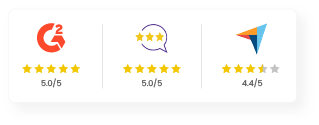A Complete Guide
LXP vs. LMS: Understanding the Differences,
Features & Use Cases
Download Guide
LXP vs. LMS: Understanding the Differences
When it comes to LXP vs LMS, it is important to note that both platforms offer stellar digital learning and each adopts a unique approach to the actual learning process. However, to get an overview of the LXP and LMS comparison, we need to focus upon the features that each offers and the different use cases for LXP and LMS.
Key Features of an LXP
Content Curation: LXPs excel in gathering content from diverse sources, including external courses, videos, articles, blogs, podcasts, and social learning platforms. They present learners with a curated library that is relevant and tailored to their individual learning goals.
Personalized and Adaptive Learning: Using algorithms, LXPs analyze learners’ preferences, skills, and objectives. Armed with this insight, they deliver personalized content recommendations and adaptive learning paths, customizing the learning experience to each individual.
Social Learning and Collaboration: With a focus on collaboration, LXPs foster social learning through features like discussion forums, chat rooms, and the ability to share insights. This creates an interactive environment, promoting engagement among learners.
User-Generated Content: Encouraging active participation, LXPs empower learners to create and share their content, promoting knowledge sharing and peer-to-peer learning. Whether through articles, videos, podcasts or presentations, learners contribute to the collective learning experience.
Analytics and Insights: LXPs offer advanced analytics, providing administrators with in-depth insights into learner engagement, content usage, and overall learning effectiveness. This data empowers organizations to make informed, data-driven decisions for continuous improvement in training programs.
Key Features of an LMS
Course Organization: LMS platforms excel in creating and managing courses, empowering administrators to structure training materials, set prerequisites, and monitor learners’ progress effectively.
Content Centralization: LMS platforms provide a centralized repository for diverse e-learning content, allowing administrators to seamlessly store and manage documents, videos, presentations, and assessments.
Enrollment and Progress Tracking: Administrators leverage LMS platforms to enroll learners, monitor their progress, assess completion rates, and generate insightful reports for evaluating individual and group performance.
Assessment Tools: LMS platforms come equipped with in- built assessment tools, facilitating the creation of quizzes, exams, and assignments. This feature empowers administrators to evaluate learners’ comprehension and knowledge retention.
Certifications: Ideal for organizations with compliance training needs, LMS platforms offer features for tracking completion, managing re-certification cycles, and ensuring adherence to regulatory standards.
Use Cases for LXP and LMS
Where LXPs actively prompt learners to interact with training materials, an LMS serves as a valuable tool for compliance and certification requirements. LXPs operate on an employee-driven model, allowing learners to choose the content they wish to engage with, whereas LMSs are predominantly administrator-driven.
Let’s look at some use cases to better understand when an LXP is the right choice and when an LMS is the right one:
Checklist to see if an LXP is the right fit for you:
- Your training approach prioritizes adaptive and personalized Learning experiences.
- Your organization intends to source a diverse array of external third-party content
- Your workforce comprises self-guided learners who prefer to independently shape their learning journeys and curriculum.
- Your emphasis is on comprehensive data and analytics capabilities, mainly those creating personalizing training experiences.
- Your training initiatives highlight the development of soft skills, leadership qualities, and experiential or conceptual learning.
- You look at social, mobile, collaborative and on-demand aspects as pivotal in shaping your employees’ learning experiences.
- Your plan involves delivering a mix of mobile and desktop learning, allowing for both self-directed and anytime, anywhere, formal and informal online training.
You aim to foster a culture where employees actively contribute to and share their own content as part of the learning experience.
Checklist to see if an LMS is the right fit for you:
- Your organization mainly relies on internally developed eLearning content.
- The key training requirement is onboarding for employee groups.
- The primary need centres around compliance-training content.
- You need both in-person (live or virtual) training and eLearning alternatives.
- Employees typically engage in online training assigned by managers or training administrators.
- You need access to essential data and analytics, indicating learner progress with factors such as time spent, completion rates, and quiz scores.
- Regular generation and distribution of reports are essential to meet regulatory obligations.






